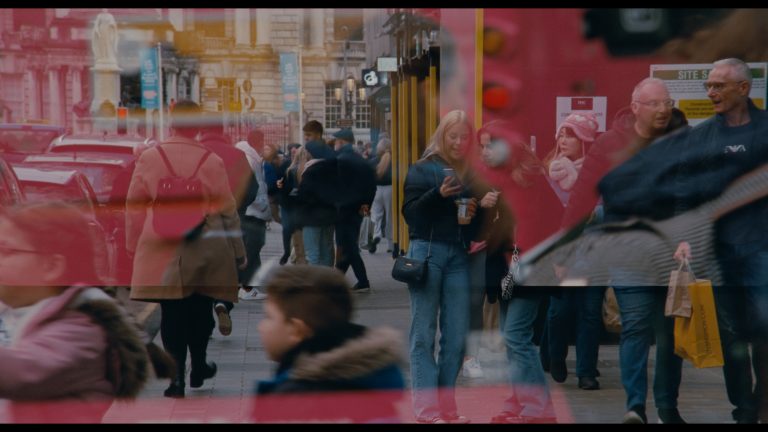 Installation view of Sean Lynch and Laura Ní Fhlaibhín, Banana Accelerationism, The Complex, Dublin
Courtesy of the Complex. Photo: Kate-Bowe O’Brien.
Installation view of Sean Lynch and Laura Ní Fhlaibhín, Banana Accelerationism, The Complex, Dublin
Courtesy of the Complex. Photo: Kate-Bowe O’Brien.
The only trouble with an exhibition like this, in which the character of each piece is acquired by its immersion within the whole, is knowing where to start. Luckily, we can take guidance from the title: Lynch and Ní Fhlaibhín were inspired by the fact that the Complex was once used as a storeroom not only for bananas, but for the heavy, industrial equipment that was used to accelerate the banana-ripening process. Ní Fhlaibhín’s research into this procedure leads to one of the most arresting contributions to the show; namely, a handful of transparent containers with a strange, molten gauze sealing the top. These vessels contain a pale, amber liquid, and within, a gelatinous membrane. This, we are told, is banana DNA. More accurately, it is a concretion of DNA material that has been rendered by a chemical that separates out everything else.
Ní Fhlaibhín’s work dramatically stages a synthesis of art and science, typical of the show’s overall aesthetic, as well as creating a template for the exhibition’s oblique approach to its historical material. Her ‘earthworm hotels’, for instance, are born from the same nutritive ground: in these living installations, the artist acquired a set of hotel mini-bar fridges, removed their mechanical innards, gas cylinders, etc., filled them with mulch, soil, compost, and fallen leaves, and then released dozens of earthworms. This artwork references the excavation of St. Mary’s Abbey that began last year, precipitated by a routine dig to prepare the site for a new hotel. Workers on the site discovered dozens of skeletal remains, which prompted a full-scale archaeological intervention led by Edmond O’Donovan, director of excavations for Courtney Deery Heritage Consultancy. Some of the burial sites are over a thousand years old, predating the abbey itself, which suggests that it was constructed on the grounds of an existing Christian settlement. Lynch’s documentary-like footage of the excavation site is an informative contribution, providing valuable historical context to the events that the abstract pieces silently address.
 Installation view of Sean Lynch and Laura Ní Fhlaibhín, Banana Accelerationism, The Complex, Dublin.
Courtesy of the Complex. Photo: Kate-Bowe O’Brien.
Installation view of Sean Lynch and Laura Ní Fhlaibhín, Banana Accelerationism, The Complex, Dublin.
Courtesy of the Complex. Photo: Kate-Bowe O’Brien.
Indeed, the burial excavation is a focal point for the show, and several threads lead back to it. The earthworm hotels are connected by a forty-metre-long soil-pipe system that allows the worms to travel and circulate, zigzagging throughout the exhibition space. The pipes act as a kind of plinth for several constellated artworks, including two sets of robes and slippers that reference the earthworm species European Nightcrawler and Red Wigglers. The visual design of these fictitious hotel brands is, in turn, a replica of the decorative stonework found in the excavation of the abbey, with examples of the real carved stonework exhibited alongside. If that weren’t reflexive enough, the style of decoration these stones feature is named ‘vermiculation’, which comes from the Latin vermiculus meaning ‘little worm’, owing to the way the carved rivulets resemble worm tracks in soft mud and soil.
This is a clear demonstration of the site-specific nature of this exhibition. O’Gorman conducted several walkthroughs of the building and adjacent sites with the artists as they prepared for the exhibition. According to O’Gorman, ‘There is not a great deal of natural light inside and there are a lot of doors leading to interconnecting corridors, which are dark and imposing. It begins to get hard to pinpoint where you are in the building in relation to the outside environment.’ As O’Gorman brought the artists deeper and deeper into the labyrinth, he continued ‘to saturate them with information about the site, its historical uses and anecdotes [he] gleaned since working here, hoping that the cocktail of facts and fiction, infused with fruit ripening chambers, religious settlements, and ancient burial sites would stimulate them’.
 Installation view of Sean Lynch and Laura Ní Fhlaibhín, Banana Accelerationism, The Complex, Dublin.
Courtesy of the Complex. Photo: Kate-Bowe O’Brien.
Installation view of Sean Lynch and Laura Ní Fhlaibhín, Banana Accelerationism, The Complex, Dublin.
Courtesy of the Complex. Photo: Kate-Bowe O’Brien.
This stimulation is clear in the resulting installation. Banana Accelerationism contains a series of ambitious and fundamentally eccentric works that stage the artists’ responses to the building, its surroundings, and the local area, with unique sensitivity and a careful attunement to artistic narrative and exhibitional cross-currents. It also conveys a particular impression of the passage of time – not immediate, minute-by-minute time, but the flow and movement of epochs and eras. The artists’ work experiments with the unfolding phases of history by focusing attention on a small patchwork of buildings in Dublin’s north inner city. This is an exhibition that is immersed in a complex and poetic temporal environment, in which historical episodes are referenced with just enough coherence to allow you to glimpse them before they dissolve, as porous as the soil through which the earthworms travel.
Tom Lordan is a writer based in Dublin.




